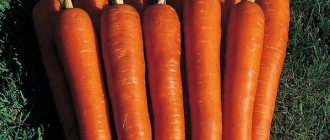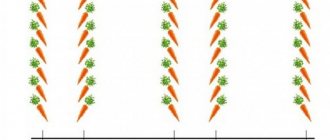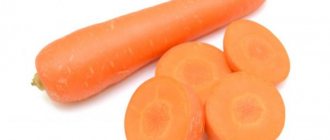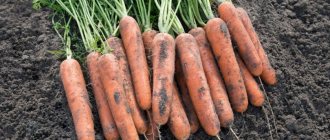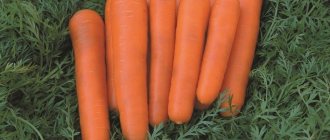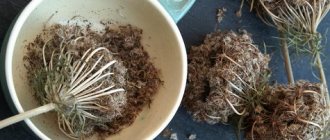What do Vita Longa and Bangor F1 carrots have in common?
Carrot crops Vita Longa and Bangor F1 are grown on large farms and in gardens. In regions with difficult climatic conditions, it produces consistently high yields of sweet root crops with good shelf life.
Description of Dutch carrots Vita Longa and Bangor F1
The Vita Longa variety and hybrid Bangor F1 carrots were created by breeders of the Dutch agronomic company Bejo Zaden.
For Vita Long, the period from full germination to harvesting is 160 days .
Carrots belong to the Chantane variety. Produces uniform orange roots with smooth skin:
- medium length – up to 15 cm;
- diameter 4-6 cm;
- in shape – blunt-ended or slightly pointed;
- with a dry matter content of 10-11%, including total sugar 7-8%
- containing provitamin A – 9-12 mg per 100 g of raw material.
It is characterized by good keeping quality and high commercial yield - 83-95%.
The Bangor F1 hybrid has a growing season of 110 days .
Root crops are distinguished by uniformity and high commercial qualities. Belongs to the Berlikumer variety.
Distinctive features:
- peel and core color – orange;
- fruit length – 20-25 cm, diameter 3-5 cm;
- yield of marketable products 75-90%;
- contains 10.5% dry matter, of which 6% total sugars;
- provitamin A – 10 mg per 100 g of raw material.
Both varieties produce juicy root vegetables that are suitable for processing into juices, drying and fresh consumption.
Main characteristics of the Vita Longa variety and the Bangor F₁ hybrid:
| Name | Ripening period | Root weight, g | Productivity per hundred square meters, kg | Regions of admission | Sustainability |
| Vita Longa | Mid-season | 100-350 | 200-490 | Northwestern, Central, Volga-Vyatka, Central Black Earth, Middle Volga, Lower Volga, Ural, Siberia, Far Eastern | Alternaria blight |
| Bangor F₁ | Early ripening | 120-350 | 196-270 | Northern, Northwestern, Central, Volga-Vyatka, Ural, Siberia, Far Eastern | Cercospora |
During mechanized harvesting, the leaf petioles of this carrot are not damaged.
The variety and hybrid are characterized by high resistance to bacterial diseases.
The main advantages and disadvantages of Vita Long and Bangor F1
The root crop of the Vita Longa variety has a thin core - its diameter of the total diameter is less than 30%. Root crops protrude slightly above the soil surface. The variety is highly resistant to brown leaf spot.
Bangor F₁ forms smooth, uniform root crops that are equal in length . It is characterized by 100% keeping quality during long-term storage. Over a large feeding area, it grows root crops weighing 400-500 g.
The variety and hybrid have persistent resistance to greening of root crops . Gardeners did not identify any shortcomings when growing them.
Features of planting and growing
Any soil is suitable, except clean sand and heavy clay . The highest yields are obtained on light loamy soils and peat bogs.
Manure is applied a year before planting under the predecessor crop - cabbage, potatoes, tomatoes, cucumbers, legumes. It is not recommended to grow carrots after perennial herbs and representatives of the Apiaceae family - parsley, dill, celery. These crops are parasitized by the carrot fly and pathogens dangerous to carrots - the causative agents of white rot, Alternaria blight, and brown spot.
For carrots, a deep arable layer is formed in which the root crop will develop:
- clear the area of stones;
- dig up the soil to a depth of 25-27 cm;
- loosen to ensure the flow of air and underground moisture to the root crops.
Phosphorus-potassium fertilizers are applied during autumn digging . Nutrients are available to carrots when the soil reaction is slightly acidic (pH 6.5).
Important! 10 days before planting, the seeds are placed in a canvas bag and buried on the site in moist soil. Then they are taken out, dried for half an hour at room temperature and sown.
Dutch carrot seeds can be soaked in one of the solutions heated to 30°C:
- for 1 liter of water – 1/3 tsp. boric acid and 1/2 tsp. nitroammofoski;
- 1 liter of water, potassium permanganate, 1/2 tsp. fertilizers;
- 1 liter of water and 1 tbsp. l. wood ash.
After a day, the seeds are rinsed , wrapped in a damp cloth and placed in the refrigerator for 3-4 days. Then they are taken out, slightly dried and sown.
Sowing dates depend on the weather. The minimum temperature for seed germination is +4…+6°С, the optimal temperature is +18…+20°С. Spring sowing begins as soon as the soil dries, winter sowing begins 2 weeks before frost.
The seeding rate per 1 m² is 100 seeds . The seeding depth on heavy soils is 1-1.5 cm, on light soils 2.5-3.5 cm. In regions with dry springs, seeds are buried to a depth of 5 cm.
They are sown in the beds in furrows located at a distance of 20 cm from each other, or using the tape method: the distance between the tapes is 30-45 cm, between the rows 18-20 cm.
The early ripening hybrid Bangor F₁ is grown in ridges , which are cut in the fall. In spring, the soil in the ridges quickly ripens at a depth of 15-20 cm, which allows for quick sowing and an early harvest.
Nuances of care
Shoots appear on days 6-20 . After watering or rain, the soil between the rows is loosened to a depth of 3 cm, trying to prevent the formation of a crust. At the same time, weeds are destroyed.
Thinning begins when the carrots have 1-2 true leaves. Leave a gap of 3-4 cm between the plants, compact the soil around the root and water with warm water.
Long-fruited carrots require careful attention to watering:
- young shoots are watered 1-2 times a week at 3-4 l/m²;
- root vegetables the thickness of a pencil – once a week, 10 l/m²;
- for larger root crops, increase water consumption to 20 l/m².
Alternating dry periods with abundant watering leads to cracking of carrots. A month after the emergence of seedlings, the first fertilizing is done - 1 tbsp is diluted in 10 liters of water. l. nitrophoska. 5 liters of solution are consumed per 1 m². After 2.5 weeks, fertilizing is repeated - 7-8 l/m². The most dangerous pests and diseases :
- The carrot fly is especially dangerous in wet areas located near bushes and on peaty and swampy soils. The leaves turn bronze and die. Covering crops with non-woven material in the phase of appearance of true leaves is effective against carrot flies. Treated with Decis Profi and Tsiper.
- Carrot psyllid spreads in areas near coniferous forests. Carrot leaves dry out. Plants are sprayed with tobacco dust or soap solution.
- Sources of infection with black rot are soil, weeds and seeds. The main symptom is blackening of the stem. The petioles tend to the ground. Spraying with the preparation "Rovral" is used.
- Brown spot spreads through weeds and infected seeds. Brown constrictions appear on the lower part of the stem, yellow spots on the leaves. Plants are treated with a decoction of celandine or horsetail.
- The causative agents of cercospora blight are transmitted through plant debris. Light brown spots with a light center, covered with plaque, appear on the leaves. For prevention, treat with a weak solution of Bordeaux mixture.
General preventive measures include maintaining crop rotation, deep digging of the soil in autumn and the destruction of plant debris, especially weeds of the Celery family.
Harvest and storage
The safety of Vita Long is 93%, Bangor F₁ is 96-98% . Harvesting of mature root crops begins before the onset of autumn frosts.
Carrot “Bangor F1” 1g
Carrot “Bangor F1” 1g
100% satisfaction guarantee
from goods from your order
Trees from our nursery
Fully adapted to harsh Russian winters
Minimum order amount 1300 rub.
All orders are sent immediately after confirmation by the operator.
We control the expiration date
All products, without exception, are checked at the warehouse
Payment upon receipt
Be confident in the quality of planting material
Favorable delivery from only 300 rubles
Accelerated delivery time for your order and a half-reduced percentage for sending money thanks to a close partnership with Russian Post
Your product
All our seeds do not contain Genetically Modified Organisms. No harm to health. The seeds comply with the requirements of international standards and GOST RF 12260-81.
Carrot “Bangor F1”.
It is one of the hybrid Dutch carrot varieties.
The length of the root crop of this variety is about 20 cm, and the weight is up to 200 g. Sometimes specimens weighing 350–400 g are found. Externally, the root crop has the shape of a cylinder with a diameter of 4–5 cm. The surface is smooth. The tip of the root is slightly rounded, and the head is slightly depressed. The color of the core and surface is orange. This carrot variety ripens in 100 to 110 days. On average, the yield is 2.2 kg/m^2, which can be called a low indicator for carrots. Advantages of the variety:
possibility of long-term storage of the crop:
rich in vitamin B;
high resistance to various diseases;
high resistance to cold;
good taste;
Suitable for baby and diet food.
Agricultural technology for growing carrot seeds
Carrots are valued for their sweet fruits with a lot of vitamins.
This vegetable does not have any special requirements for soil composition, care and weather. It is enough to carry out a number of simple agricultural techniques during the growing season in order to fully provide yourself with your own harvest for the whole year. Technology of growing from seeds
- Carrot seeds can be placed in the ground once the threat of severe frost has passed.
- It is convenient to sow the area in parts, with a break of a couple of weeks to a month. This will first allow you to get an early harvest of a frost-resistant vegetable, and then always have young carrots on hand for salads.
- This crop does not like replanting, so the choice of site is considered carefully.
- The place should be well lit by the sun. The soil needs to be light, with good drainage, free from stones. Add compost to heavy soil.
- The soil is loosened; for later varieties, the soil is treated more deeply.
- When sowing, maintain an interval of about 30 cm between adjacent rows. The seeds are evenly distributed at a depth of 1 cm and sprinkled with soil.
- Water the soil moderately, avoiding overmoistening the seeds. This is especially important before seedlings emerge.
- It is convenient to grow carrots together with radishes. They have different ripening periods and similar growing conditions. Radish shoots will appear much earlier and will make caring for carrot beds easier.
- Then the early vegetable will be harvested, and the carrots will just enter the phase of active development.
- Carrot seeds germinate 2-3 weeks after sowing.
- In thickened plantings, remove excess plants when the plant height is about 7 cm.
- Leave the bushes at a distance of 2-3 cm from each other.
Shipping and payment
Details about delivery conditions
Delivery terms
are indicated in working days (not counting the day the order is transferred).
The delivery period
begins from the moment the order status changes to “Transferred for delivery”.
The period for collecting and completing orders
is from 1 to 2 days.
You can check with our operators for all details on delivery conditions by calling: +7(499)653-85-65
Attention! For orders over 4,000 rubles, delivery is free!
Delivery in Moscow and Moscow region
Courier delivery within the Moscow Ring Road Delivery cost: 250 rubles Delivery time: 1-2 days Delivery time: Mon-Sun from 10:00 to 20:00
Courier delivery outside the Moscow Ring Road up to 30 km Delivery cost: 370 rubles Delivery time: 1-2 days Delivery time: Mon-Sun from 10:00 to 20:00
Courier delivery outside the Moscow Ring Road more than 30 km Delivery cost: 670 rubles Delivery time: 1-2 days Delivery time: Wed and Sat from 10:00 to 20:00
Delivery to Order Pickup Points A complete list and terms of delivery to Order Pickup Points in Moscow and the Moscow region can be found >>here >here >here
What delivery looks like through the eyes of our customer
What's in the black box? What you don’t have to worry about is our delivery. This is entirely our concern. We approached this process in detail. And we managed to achieve what 90% of online stores fail to achieve.
Namely, to give our delivery 3 main qualities:
1. Delivered quickly 2. Safely 3. Safely
And we have another strong feature. Namely:
Fast dispatch guarantee*
*does not apply to products in the “Related Products” section
Read also: Leningrad giant currant: description of the variety, planting and care
Many online stores are sluggish and leisurely. They accept the order and can collect it for several days. Meanwhile, the earth is waiting, the gardener is waiting, the seeds are running out of time. In response to this, we have an ironclad rule:
If you place your order before 17.00, we will collect and ship it on the same day!
If we do not comply with this rule, we will pay you a penalty for each day of delay.
Carrot Bangor F1
For cultivation in domestic latitudes, farmers are offered various varieties and hybrids of carrots, including foreign selection. Moreover, hybrids obtained by crossing two varieties combine the best qualities of their ancestors. Thus, some of them have amazing taste and external characteristics, high resistance to diseases, cold, and suitability for long-term storage. One of the best hybrids is the Bangor F1 carrot. The main characteristics of this variety, taste and external description and photo of the root crop are given in the article.
Description of the hybrid
The Bangor F1 carrot variety was developed by the Dutch breeding company Bejo. According to the external description, the hybrid is classified as the “Berlicum” variety, since the root crop has a cylindrical shape with a rounded tip. Its length is in the range of 16-20 cm, weight is 120-200 g. In cross section, the diameter of the root crop is 3-5 mm. You can evaluate the external qualities of carrots of the “Bangor F1” variety in the photo below.
100 g of Bangor F1 carrots contain:
- 10.5% dry matter;
- 6% total sugar;
- 10 mg carotene.
In addition to the main substances, carrots contain a complex of vitamins and microelements: B vitamins, panthethonic and ascorbic acids, flavonoids, anthocyanins, fatty and essential oils.
The microelement composition affects the external and taste qualities of the root crop. Thus, a relatively high amount of carotene gives the root vegetable an orange-red color. The pulp of Bangor F1 carrots is very juicy, sweet, and moderately dense. The root crop of this variety is used in the preparation of fresh vegetable salads, canning, the production of baby and dietary food, and multi-vitamin juices.
Agricultural technology
The variety "Bangor F1" is zoned for the Central region of Russia. It is recommended to sow it in April, when the likelihood of frosts and prolonged cold spells has passed. Loose sandy loams and light loams are best suited for cultivating vegetables. The required soil composition can be prepared by mixing the soil available on the land plot with sand, humus, and peat. Sawdust treated with urea should be added to heavy clay. The depth of the arable layer for growing the Bangor F1 variety must be at least 25 cm.
Carrot seeds should be sown in rows. The distance between them should be at least 15 cm. It is recommended to maintain a 4 cm interval between seeds in the same row. To maintain the required distance, it is recommended to use special tapes with seeds or glue them yourself onto paper analogues. If the required intervals are not observed, it is necessary to thin out the carrots 2 weeks after emergence. The depth of planting the seed should be 1-2 cm.
During the growing process, the crop requires systematic watering. In this case, the depth of soil saturation should be greater than the length of the root crop. All necessary fertilizers should be added to the soil in the fall, which will eliminate the need for additional fertilizing. To combat carrot flies (if necessary), during the cultivation process, you can treat with ash, tobacco dust, wormwood, or special agrochemicals. By watching the video you can learn in detail about the agrotechnical features of growing carrots:
Under favorable growing conditions, carrots of the Bangor F1 variety ripen 110 days after sowing the seed. The crop yield largely depends on the nutritional value of the soil, compliance with cultivation rules and can vary from 5 to 7 kg/m2.
Similar products
Carrots of Amsterdam JOHNSONS
Raspberry Rubin SeDeK 0.1 g
Carrot Narbonne F1 3 g H9 Gavrish 0.3 g
More products Delivery
Delivery of online orders
Goods ordered in the OBI online store are delivered throughout Bryansk and the Bryansk region within 50 km from the city limits. Delivery costs are automatically calculated when placing an online order, based on the weight of the product and delivery area.
Minimum order amount for free delivery:
- > 3,000.00 ₽ — for orders weighing up to 5.0 kg
- > 6,000.00 ₽ — for orders weighing up to 30.0 kg
Read also: When to dig up garlic: harvesting and storing garlic
The courier service delivers small-sized orders (weighing up to 30 kg) to the buyer’s door, large-sized ones to the entrance (gate, gate) of the house. Delivery includes free unloading of goods from the vehicle and their transfer within 10 m.
Delivery date and time
Next day delivery is available when ordering before 6:00 pm. You will be offered a choice of one of two 7-hour delivery intervals:
- — from 10:00 to 16:00
- — from 15:00 to 22:00
If you want to reduce the waiting period, you can choose one of the 3-hour delivery intervals for an additional fee:
- — from 10:00 to 13:00 +250.00 ₽.
- — from 13:00 to 16:00 +200.00 ₽.
- — from 16:00 to 19:00 +200.00 ₽.
- — from 19:00 to 22:00 +250.00 ₽.
Rescheduling the date and changing the delivery time interval is possible no later than 24 hours before the previously agreed date and time.
You can learn more about the operating conditions of the courier service in the section Delivery of online orders.
